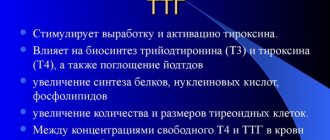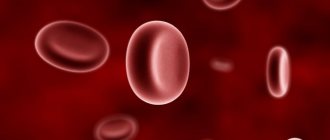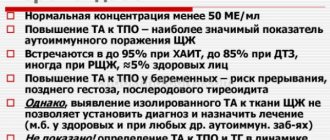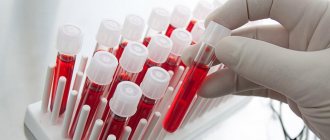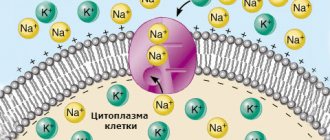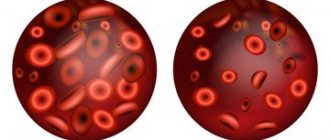The thyroid gland in the human body performs the function of synthesizing biologically active compounds. TSH, T3, T4 are hormones responsible for energy metabolism, oxygen supply to cells, growth and normal functioning of organs and tissues.
The thyroid gland in the human body performs the function of synthesizing biologically active compounds. TSH, T3, T4 are hormones responsible for energy metabolism, oxygen supply to cells, growth and normal functioning of organs and tissues.
Decoding the TSH analysis
Let's start from the beginning - with TSH. In my case, TSH = 9.02 [0.4-3.77]. What does this mean?
An increase in TSH is a sign of hypothyroidism. But 99% of endocrinologists in our country have an incorrect definition of hypothyroidism firmly rooted in their heads. Do you, dear reader, know what hypothyroidism is? You may have heard or read somewhere that “hypothyroidism is a deficiency of thyroid hormones” or “decreased thyroid function.”
If you look closely at my test form, you will be able to find that while TSH is elevated, I do not have a thyroid hormone deficiency. And this is not a rare case - according to the book “Blood Analysis”, more than 30% of patients with hypothyroidism have a full amount of thyroid hormones in the blood. They may not even realize that they have hypothyroidism until they accidentally end up in an endocrinologist's office (as happened to me).
What about the remaining <70% of patients with hypothyroidism? They may be deficient in T3 and T4. But this is in no way related to “decreased thyroid function.”
My favorite subject at school was physics and my higher education was in engineering and technology. Therefore, to make it easier for you to understand the essence of hypothyroidism, I will ask you to imagine the following picture in your head. Imagine that the thyroid gland is a factory worker. It produces “products” - thyroid hormones, which are consumed by the body. The thyroid gland has a higher “supervisor” - the pituitary gland (there is another, more “superior” leader - you will learn about him in the book). This overseer, the pituitary gland, has a loudspeaker through which it gives instructions to the thyroid gland. This speaker has a volume control that allows you to increase or decrease the frequency of the sound that the speaker produces.
So, I want you to imagine that TSH is the volume at which the pituitary gland gives orders to the thyroid gland. What is he ordering her to do? Produce thyroid hormones, of course!
Signs of hormonal imbalance
A normal level of free thyroxine and an increased level of thyroid-stimulating hormonal substance in most cases is manifested by a general deterioration in the individual’s condition. Untimely recognition of the disease and lack of treatment will quickly lead to serious pathological conditions.
Symptoms of elevated TSH with normal T4:
- the functions of the digestive tract are impaired;
- there is a decrease in appetite or it is completely absent;
- apathy occurs;
- insomnia;
- general weakness;
- physical activity is significantly reduced;
- fatigue sets in quickly;
- In pregnant women, the size of the thyroid gland increases.
TSH and stimulation amount
So, we come to the main thing and now you will understand what nonsense the definitions of hypothyroidism are given by doctors and with which the Internet is littered. Decoding the TSH analysis will become clear to everyone!
TSH is a pituitary hormone designed to stimulate the thyroid gland. Therefore, hypothyroidism is a stimulatory symptom. Not a deficiency of thyroid hormones and not a decrease in thyroid function, but a sign of excessive activation of the thyroid gland through TSH!!!
If there are enough thyroid hormones, but TSH is increased more than normal, this condition will still be called hypothyroidism.
The TSH indicator allows us to classify our state of hypothyroidism according to the amount of stimulation. The more TSH, the louder the pituitary gland “screams” and the more it forces the thyroid gland to tense up and produce hormones. In the book, Dr. Ushakov describes three degrees of stimulation of the thyroid gland - minor, moderate and significant.
Interpretation of my blood tests for thyroid hormones
In my case, TSH = 9.02 [0.4-3.77]. Such an excess of the upper reference value (up to 7-10 mU/l) indicates a clear, but relatively small activation of the production of thyroid hormones. This tells me that my body’s needs for these hormones have increased, but so far there are enough compensatory forces and the thyroid gland, due to increased production, fully meets these needs. This degree of stimulation of the thyroid gland is called minor hypothyroidism .
You can read more about the classification of hypothyroidism in Dr. Ushakov’s book “Blood analysis for thyroid diseases.”
Thyroxine levels during pregnancy
The pregnancy period is characterized by the special state of the female body and all the processes occurring with it, including the production of hormones. Therefore, to analyze thyroxine levels, a completely different scale of normal values is used.
During this period, the production of the TSH protein, which binds most of the tetraiodothyronine synthesized by the thyroid gland, greatly increases. The levels of bound T4 will always exceed normal values, which in no way affects the health of the mother and unborn child
Of particular importance during this period is free thyroxine, which during the first trimester of pregnancy is responsible for the development of the embryo’s brain. Therefore, it is necessary to pay special attention to the indicators of this particular hormonal form of tetraiodothyronine.
If clinical studies reveal a significant excess of free thyroxine, the endocrinologist usually prescribes drug treatment to ensure the safety and normal development of the fetus.
T3 St. and T4 St.
If your doctor only referred you to TSH, how is he going to determine the sufficiency of thyroid hormones? I came across just such a doctor who, based on only one elevated TSH, considered it necessary to prescribe me a medium (50 mcg) dose of L-thyroxine. Now, years later, I understand that that endocrinologist was simply not familiar with the principles of quantitative assessment and the relationship between thyroid hormones.
I am very glad that a similar story will not happen to me or to you, because the knowledge that Dr. Ushakov gives in his textbook for patients far exceeds the level of an “ordinary” endocrinologist.
If you look at the figure above, where I displayed the transcript of my analyzes on a checkered piece of paper, you will notice that for each indicator I drew segments representing the laboratory’s reference interval. For hormones T3 and T4, these segments must be divided into 4 parts.
My T4 hormone levels are st. and T3 St. are in the zone of average 50% of the norm (shaded area), that is, in the optimum. At the same time, the red flag T4 St. is located slightly to the left of the T3sv flag. This condition is called thyroid compensation.
What does it mean? That the thyroid gland has enough compensatory capabilities to fully supply the body with hormones. In the case of thyroid compensation, there is no need to prescribe levothyroxine, but this is done everywhere, schematically, “just in case.”
Read what the concepts of “subcompensation” and “decompensation” mean in the section “Compensatory states of hormonal metabolism” on page 101 of the textbook for patients “Blood analysis for thyroid diseases”.
What to do if you are sick
Actions with increased levels of thyroid-stimulating hormone are always different - it all depends on the individual characteristics of the human body. Only a doctor can decide what needs to be done in each specific situation; self-diagnosis and self-medication will not lead to anything good
It is important not to rush into action; most often the patient is sent for a repeat test to confirm hidden hypothyroidism. Taking a blood test for biochemistry
If a person is diagnosed with anemia, the diagnosis is considered confirmed. There is no reason to panic when diagnosing a disease
It is important to start treatment in a timely manner so that the person’s quality of life remains at a high level. Treatment is carried out through the use of hormonal therapy
Antibodies (anti-TPO and anti-TG)
As Dr. Ushakov writes in his book, most often patients experience an increase in antibodies to TPO. For me, it’s the other way around—antibodies to TPO are normal, but antibodies to TG are elevated, which happens less often. Together with the picture of my ultrasound, this indicates an autoimmune process in the thyroid gland.
What do the abbreviations TPO and TG mean?
TPO is thyroid peroxidase, an oxidizing agent found in thyroid cells and involved in the formation of hormones (thyroxine and triiodothyronine). We can say that anti-TPO are antibodies to thyrocytes (thyroid cells).
According to Dr. Ushakov, an increase in AT-TPO occurs
Thyroglobulin (TG) is a protein substance found in the colloid of thyroid follicles and takes part in the formation and accumulation of hormones. Therefore, we can say that anti-TG are antibodies to thyroid tissue.
Antibodies to TG correspond predominantly to depletion of gland tissue rather than to its actual overstrain.
Assessment of antibody levels is important because it reflects the degree of overstrain and exhaustion of the thyroid gland.
For example, with an AT-TPO value of 734.8 U/l [0-35], one can think not only of a moderate increase in these antibodies, but also of the same moderate overstrain and some depletion of thyroid tissue.
What did I get?
According to Dr. Ushakov’s classification, my blood test pattern corresponds to minor hypothyroidism with thyroid compensation and a moderate increase in antibodies to TG. The introduction of L-thyroxine into the body is not required, since there are enough thyroid hormones, and excess hormones can worsen the condition of other organs and well-being.
What to do next?
Next, I need to understand what unfavorable factors caused increased stimulation of the thyroid gland by the pituitary gland and nervous system, which contributed to an increase in the body’s need for thyroid hormones. It is also necessary to assess the functional state of the systems that participate together with the thyroid gland in ensuring energy (basic) metabolism.
I will tell you what additional tests I took (along with tests for thyroid hormones) in the next article.
Website of the book “Blood analysis for thyroid diseases”: https://www.dr-md.ru/books/book8/
Deviations from the norm
The main function of free triiodothyronine is to provide organs and systems with oxygen, which must interact with organic molecules, resulting in the release of energy.
If the level of this substance is elevated, the body is forced to spend a large amount of resources on oxidation, which provokes excess energy.
If the level of this hormone is reduced, then the vitality of the body decreases, since all oxidation processes are inhibited.
Causes
An increase in the level of this substance can occur for the following reasons:
- hemodialysis;
- the occurrence of thyroiditis;
- HIV infection;
- the appearance of diffuse toxic goiter;
- treatment with hormonal drugs;
- the appearance of malignant neoplasms;
- development of porphyrin disease.
Thus, an increase in the level of free triiodothyronine indicates the presence of various pathologies of hereditary and acquired nature.
A decrease in the amount of this substance can occur with the following diseases:
- adrenal hypofunction;
- insufficient amount of protein in food;
- hypothyroidism;
- persistent mental disorders.
In addition, taking staining solutions during X-ray examinations can reduce the level of free triiodothyronine. Taking anabolic steroids, antithyroid drugs, and steroids leads to the same result.
Treatment
Any deviation in the amount of free triiodothyronine from the norm requires a thorough examination and a correct diagnosis. Treatment for a person suffering from high or low levels of the hormone consists of three parts.
- Eliminating the causes, that is, treating the disease itself.
- Taking hormones that compensate for the deficiency or consequences of excess free triiodothyronine.
- Taking measures to normalize the functioning of the thyroid gland itself.
This is a general plan of action, the measures taken depend on the diagnosis and condition of the patient.



